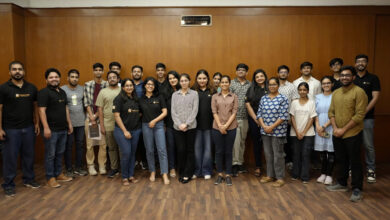Mount Litera Zee School opens doors to learning with a revamped school environment for preschoolers

The Mount Litera Zee School opened doors to pre-primary learning with the inauguration of a revamped school environment, aiming at making learning a fun and visually thrilling experience for preschoolers in July, 2022 in Karnal, Bhatinda and Patiala.
For preschoolers, the environment in the classrooms sends powerful messages, they get an aura of security and warmth from the space. Hence, this space needs the utmost designing and organizing, in a way that it reflects the free and frolic personality of the class.
A major chunk of sessions in pre-primary schooling involves learning through fun activities, and for this particular reason, the classrooms need wider spaces, storage facilities and a good display.
The Mount Litera Zee Schools sustained the learning through play mechanism for preschoolers with animated painted drawings on colorful walls, colorful desks with a group sitting arrangement, storage lockers and projector displays. This considerate revamping of the school environment would help preschoolers feel at home while learning in a fun and engaging way.
Preschool classrooms require many materials, as kids learn through activities! So, be it toys, books or games, these resources are timely used. And hence, the classrooms at Mount Litera Zee Schools now have a storage space in the classrooms for the students, allowing them to store their activity work. This in turn inculcates the value of appreciating and preserving their work in them. The students can learn nursery rhymes and moral stories through projector displays in an engaging way, ensuring they have a pictorial memory to attach to every poem or story helping them memorize it easily.
“With the touch of newness and a riot of colors at MLZS our Pre Primary Wing looks nothing short of a fairy- tale-setting to fire the imagination of young minds. Come over, we would love to show you around!” Said Ms Deep Bedi, Principal – MLZS Karnal, inviting the kiddos and their parents to experience the playfully themed learning haven themselves.
Children are more likely to feel a sense of belonging when their classroom environment feels like home, somewhere they can be themselves. Hence, the Mount Litera Zee Schools have not just taken the effort to fill and beautify classrooms for preschoolers, but also make that classroom environment a meaningful one for them. These small personal touches like small, colorful tables put together for peer-to-peer learning, storage spaces for preserving students’ work, projector displays for poems and stories narration, animated paintings on colorful walls give a playroom-like feel to the classroom, something the small kiddos can relate to and embrace with their tiny, soft arms!

Kindergarten curates and stimulates the creativity, imagination, and development of sensory motor skills by flaunting the rainbow of colors on its walls, leaving a long-lasting impact on the tender minds by nurturing their aesthetic intelligence. MLZS is incredibly pleased to launch the refurbished Pre-Primary wing’s avant-garde appearance, which also adds a spectrum of colors to every corner of its wing. – Ms Richa Tripathi, Principal – MLZS Patiala.
The Mount Litera Zee Schools of Karnal, Bhatinda and Patiala look forward to the reactions of their tiny preschoolers to the surprise awaiting them at their schools, the homelike schooling environment too awaits its tiny bubbling toddlers.






